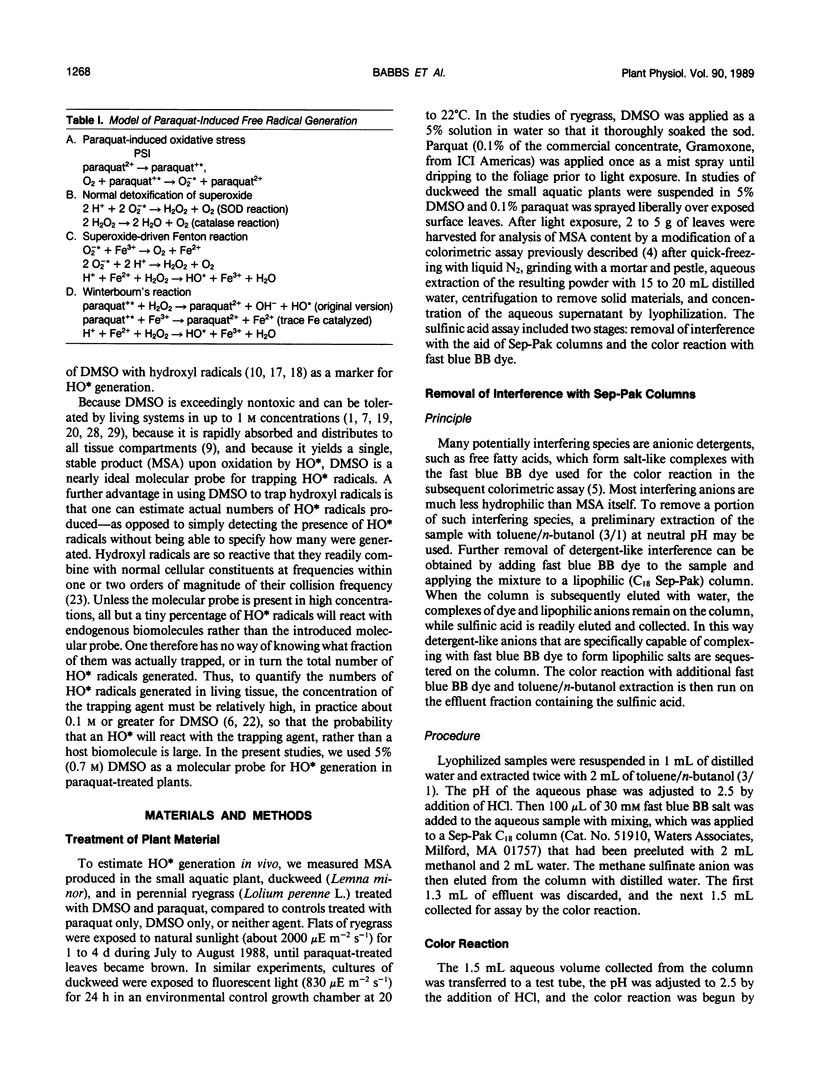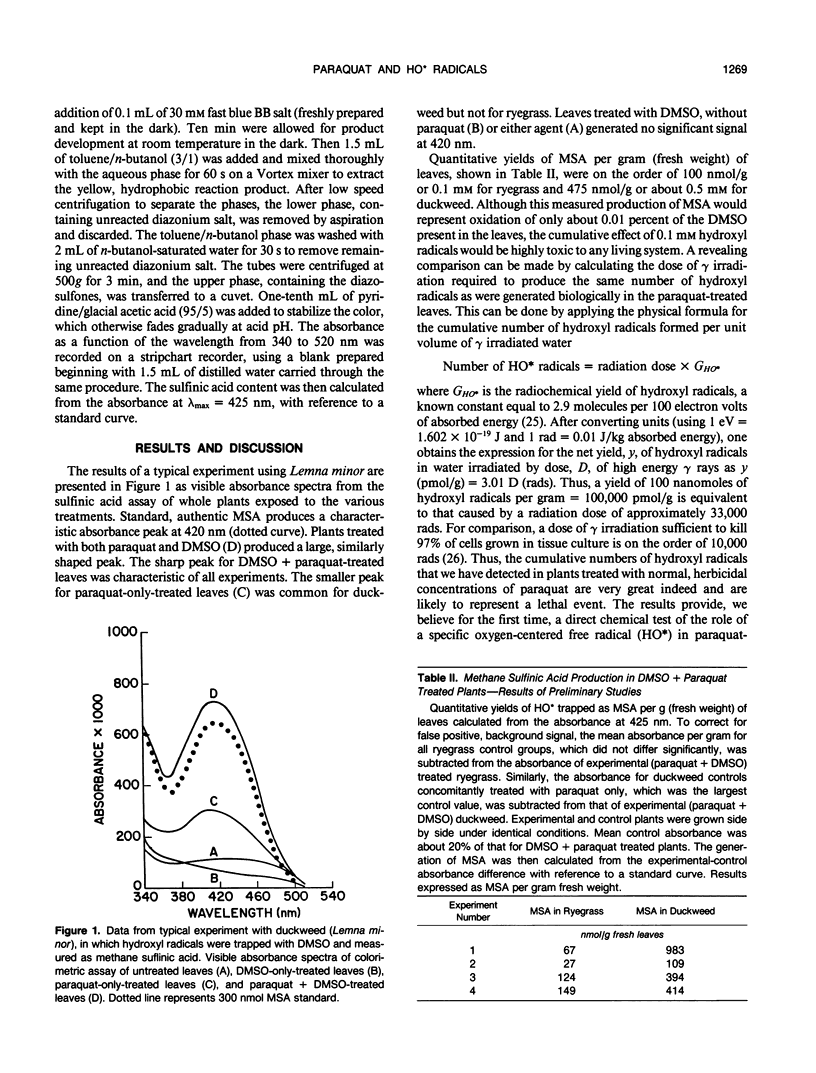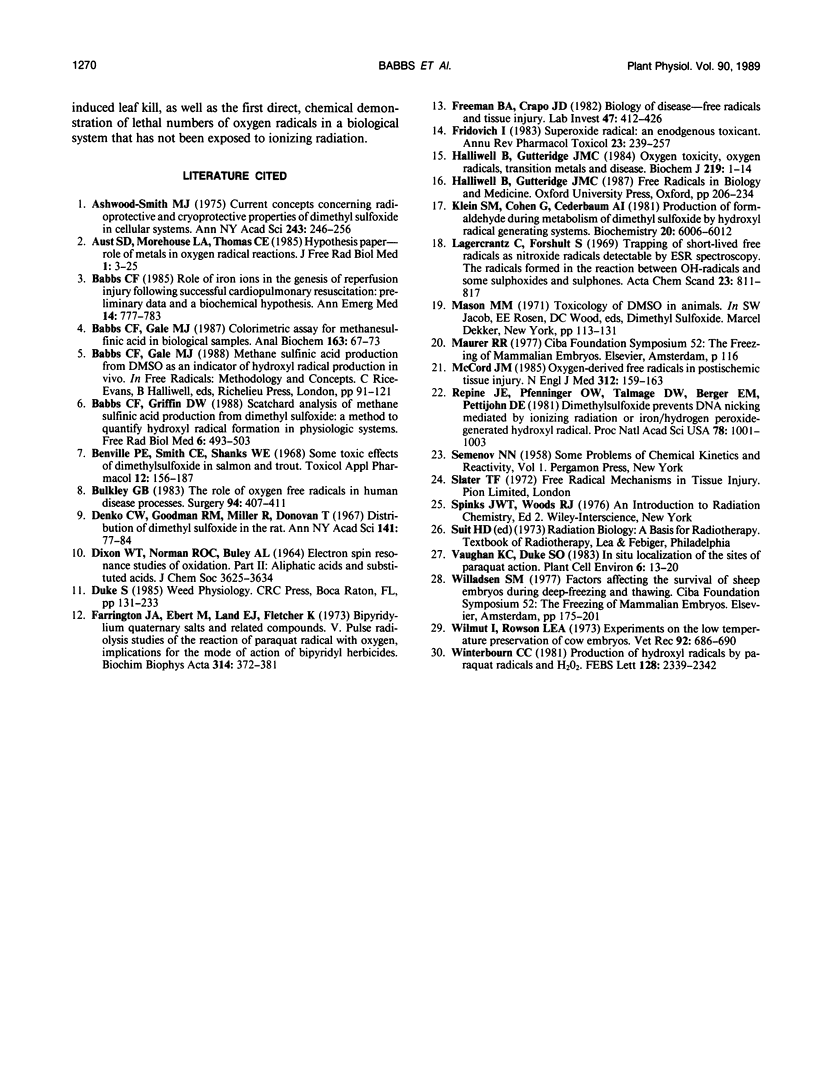Abstract
Bipyridinium herbicides, including paraquat and diquat, are believed to act by generating highly reactive, oxygen-centered free radicals within chloroplasts when treated plants are exposed to sunlight. This hypothesis has not yet been confirmed by direct chemical measurements of specific free radicals. We studied paraquat-treated plants using a new method able to detect and quantify formation of highly reactive and deleterious hydroxyl radicals (HO*), in which dimethyl sulfoxide (DMSO) is used as a molecular probe. DMSO is oxidized by HO* to form the stable, nonradical compound, methane sulfinic acid, which can be easily extracted from plant tissue and measured spectrophotometrically. Initial experiments revealed formation of extraordinary numbers of hydroxyl radicals in light-exposed, paraquat + DMSO-treated plants, equivalent at least to the cumulative number of HO* radicals per gram of fresh tissue that would be produced by 10,000 rads of gamma irradiation. This appears to be the greatest production of hydroxyl radicals yet observed in a biological system and is quite sufficient to explain the rapid death of top growth in paraquat-treated plants.
Full text
PDF



Selected References
These references are in PubMed. This may not be the complete list of references from this article.
- Ashwood-Smith M. J. Current concepts concerning radioprotective and cryoprotective properties of dimethyl sulfoxide in cellular systems. Ann N Y Acad Sci. 1975 Jan 27;243:246–256. doi: 10.1111/j.1749-6632.1975.tb25363.x. [DOI] [PubMed] [Google Scholar]
- Aust S. D., Morehouse L. A., Thomas C. E. Role of metals in oxygen radical reactions. J Free Radic Biol Med. 1985;1(1):3–25. doi: 10.1016/0748-5514(85)90025-x. [DOI] [PubMed] [Google Scholar]
- Babbs C. F., Gale M. J. Colorimetric assay for methanesulfinic acid in biological samples. Anal Biochem. 1987 May 15;163(1):67–73. doi: 10.1016/0003-2697(87)90093-5. [DOI] [PubMed] [Google Scholar]
- Babbs C. F., Griffin D. W. Scatchard analysis of methane sulfinic acid production from dimethyl sulfoxide: a method to quantify hydroxyl radical formation in physiologic systems. Free Radic Biol Med. 1989;6(5):493–503. doi: 10.1016/0891-5849(89)90042-7. [DOI] [PubMed] [Google Scholar]
- Babbs C. F. Role of iron ions in the genesis of reperfusion injury following successful cardiopulmonary resuscitation: preliminary data and a biochemical hypothesis. Ann Emerg Med. 1985 Aug;14(8):777–783. doi: 10.1016/s0196-0644(85)80056-1. [DOI] [PubMed] [Google Scholar]
- Benville P. E., Jr, Smith C. E., Shanks W. E. Some toxic effects of dimethyl sulfoxide in salmon and trout. Toxicol Appl Pharmacol. 1968 Mar;12(2):156–178. doi: 10.1016/0041-008x(68)90028-8. [DOI] [PubMed] [Google Scholar]
- Bulkley G. B. The role of oxygen free radicals in human disease processes. Surgery. 1983 Sep;94(3):407–411. [PubMed] [Google Scholar]
- Denko C. W., Goodman R. M., Miller R., Donovan T. Distribution of dimethyl sulfoxide-35S in the rat. Ann N Y Acad Sci. 1967 Mar 15;141(1):77–84. doi: 10.1111/j.1749-6632.1967.tb34868.x. [DOI] [PubMed] [Google Scholar]
- Farrington J. A., Ebert M., Land E. J., Fletcher K. Bipyridylium quaternary salts and related compounds. V. Pulse radiolysis studies of the reaction of paraquat radical with oxygen. Implications for the mode of action of bipyridyl herbicides. Biochim Biophys Acta. 1973 Sep 26;314(3):372–381. doi: 10.1016/0005-2728(73)90121-7. [DOI] [PubMed] [Google Scholar]
- Freeman B. A., Crapo J. D. Biology of disease: free radicals and tissue injury. Lab Invest. 1982 Nov;47(5):412–426. [PubMed] [Google Scholar]
- Fridovich I. Superoxide radical: an endogenous toxicant. Annu Rev Pharmacol Toxicol. 1983;23:239–257. doi: 10.1146/annurev.pa.23.040183.001323. [DOI] [PubMed] [Google Scholar]
- Halliwell B., Gutteridge J. M. Oxygen toxicity, oxygen radicals, transition metals and disease. Biochem J. 1984 Apr 1;219(1):1–14. doi: 10.1042/bj2190001. [DOI] [PMC free article] [PubMed] [Google Scholar]
- Klein S. M., Cohen G., Cederbaum A. I. Production of formaldehyde during metabolism of dimethyl sulfoxide by hydroxyl radical generating systems. Biochemistry. 1981 Oct 13;20(21):6006–6012. doi: 10.1021/bi00524a013. [DOI] [PubMed] [Google Scholar]
- McCord J. M. Oxygen-derived free radicals in postischemic tissue injury. N Engl J Med. 1985 Jan 17;312(3):159–163. doi: 10.1056/NEJM198501173120305. [DOI] [PubMed] [Google Scholar]
- Repine J. E., Pfenninger O. W., Talmage D. W., Berger E. M., Pettijohn D. E. Dimethyl sulfoxide prevents DNA nicking mediated by ionizing radiation or iron/hydrogen peroxide-generated hydroxyl radical. Proc Natl Acad Sci U S A. 1981 Feb;78(2):1001–1003. doi: 10.1073/pnas.78.2.1001. [DOI] [PMC free article] [PubMed] [Google Scholar]
- Wilmut I., Rowson L. E. Experiments on the low-temperature preservation of cow embryos. Vet Rec. 1973 Jun 30;92(26):686–690. doi: 10.1136/vr.92.26.686. [DOI] [PubMed] [Google Scholar]


